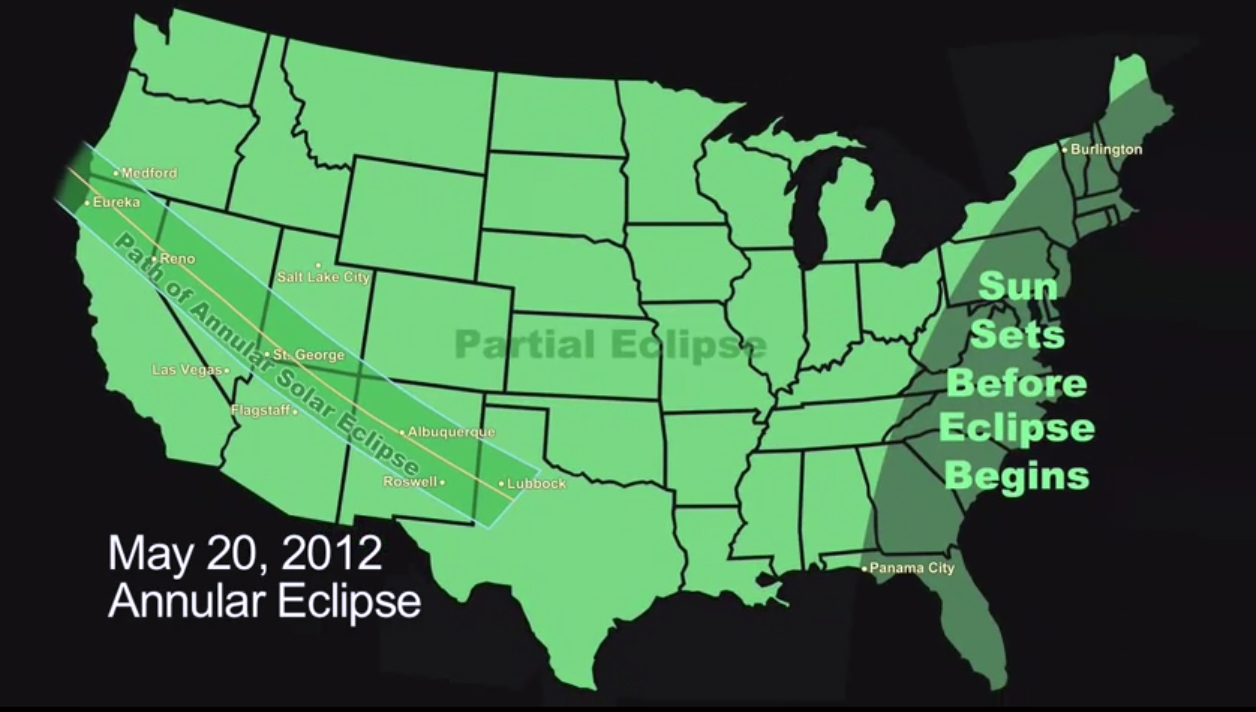Next Solar Eclipse: ‘Ring of Fire’ on May 20, 2012

Updated May 17, 4:17 pm ET
The next solar eclipse will grace the afternoon and early evening skies over much of the United States this Sunday (May 20), offering up a spectacular site for those lucky enough to see it.
A solar eclipse occurs when the moon gets directly between Earth and the sun. Sunday’s event will be an partial solar eclipse across most of the United States and Canada, and a more compelling annular solar eclipse for a narrow swath of residents in the West and Southwest. The sun sets before any of it will be visible from the East Coast, however.
During the annular eclipse, the moon will be analogous to a black dime in front of a shiny penny, with a thin “ring of fire” — sunlight that streams around the moon.
Annular eclipses occur when the moon is at or near its farthest distance from Earth on it’s non-circular orbit. Annular eclipses can be dramatic, but because they’re not total eclipses, they must be viewed with proper safety filters — looking at direct sunlight can damage your eyes.
"The ring of sunlight during annularity is blindingly bright," cautions NASA's leading eclipse expert Fred Espenak of the Goddard Space Flight Center. "Even though most of the Sun's disk will be covered, you still need to use a solar filter or some type of projection technique. A #14 welder's glass is a good choice. There are also many commercially-available solar filters."

The moon will block up to 94 percent of sunlight for those directly under the narrow path.
Sign up for the Live Science daily newsletter now
Get the world’s most fascinating discoveries delivered straight to your inbox.
The “ring of fire” will appear “as thin as a basketball hoop with a half-inch rim seen face on from about 160 feet away,” explains Joe Rao, skywatching columnist for SPACE.com. The sky won’t turn dark but for a few minutes it will transform into a strange “counterfeit twilight,” Rao said.
The annular eclipse will be visible along a path roughly 150 to 186 miles wide (240 to 300 km) that includes Redding, Calif. and heads southeast through central Nevada, southern Utah, northern Arizona, Albuquerque, New Mexico, and the Texas Panhandle. (NASA lists local times and circumstances here.)
People along but outside the main path of the annular eclipse will see a partial solar eclipse, in which the moon appears to take a bite out of the sun. Again, do not look directly at the sunlight.
The partial eclipse will be visible, weather permitting, in much of the United States and Canada.
The annular eclipse will be visible from 33 National Parks, including the Grand Canyon. It will also cast its shadow on Southern China and Japan, including Tokyo, on Monday, local time.
More Info:
How and Where to See Sunday’s Eclipse Detailed information from SPACE.com.
NASA Eclipse Map with Exact Local Times and Circumstances Scroll to your location, zoom in, then click on your town — info will pop up.
How to Safely Photograph the 'Ring of Fire' Expert photography tips from pinhole cameras to solar filters.
Robert is an independent health and science journalist and writer based in Phoenix, Arizona. He is a former editor-in-chief of Live Science with over 20 years of experience as a reporter and editor. He has worked on websites such as Space.com and Tom's Guide, and is a contributor on Medium, covering how we age and how to optimize the mind and body through time. He has a journalism degree from Humboldt State University in California.










